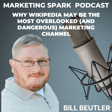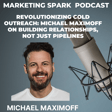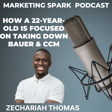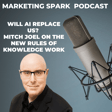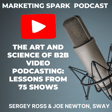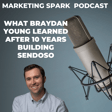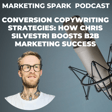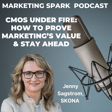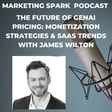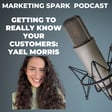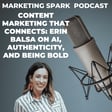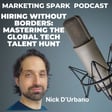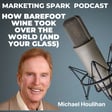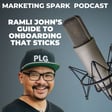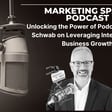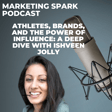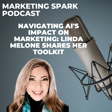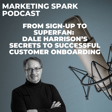Become a Creator today!Start creating today - Share your story with the world!
Start for free
00:00:00
00:00:01

Sketchnotes: Marketing with a Creative Twist
In a fast-moving marketing landscape, it's a challenge to break through and attract the spotlight.
Kacy Maxwell is taking a different and effective approach with a concept called sketchnotes that combines notetaking, doodling, and drawing.
It's a user-friendly and quick way to communicate ideas at a time when multi-tasking people scan rather than read.
In this episode of Marketing Spark, Kacy and I talked about:
- Why he embraced sketchnotes
- How B2B companies can embrace brand storytelling
- The marketing outlook for 2022
- Gated content
- His annual solitude trips.
Transcript
The Echo Chamber of LinkedIn
00:00:05
Speaker
Hi, it's Mark Evans, and you're listening to Marketing Spark. Marketers love LinkedIn. It's a great place to showcase our expertise and let the world know what we think. But it can sometimes feel like LinkedIn is marketers talking to marketers. So as you can imagine, it's hard to stand out from the crowd.
Storytelling with Sketch Notes
00:00:25
Speaker
However, one marketer doing a good job of rising above the fray is Casey Maxwell, executive marketing director with Ramsey Solutions in Nashville.
00:00:35
Speaker
He uses a really creative approach called sketch notes to talk about marketing, branding, and storytelling. And as someone who loves creativity and different approaches to storytelling, I was compelled to get Casey on the podcast. Welcome to Marketing Spark. Thanks, I appreciate it.
Nashville Snowstorm
00:00:50
Speaker
First question, what's it like to have a snowstorm in Nashville understand that it's really coming down in a place where you wouldn't expect snow to really happen?
00:00:59
Speaker
Yeah, I mean, we don't get snow here very often. And a snowstorm typically means, it can mean anywhere from one inch, that's a blizzard down here, to five or six inches. And we have had seven inches the past couple weeks, which basically shuts down the entire city. Because we've got basically one truck for the entire state, and it takes a lot for that guy to get to all the roads.
00:01:26
Speaker
We're often shut down for a good number of days. And it looks like we're going to be that for a while here.
00:01:33
Speaker
Up here in Canada, we laugh when places that don't get a lot of snow get snowstorms because we look at that and go, that's not a snowstorm. That's like a light frosting of snow. What are you guys thinking about? But if you're not prepared, I can totally understand how it would throw things into total disarray. Completely. Well, let's get back to the topic of the day. Marketing.
Personal LinkedIn Approach
00:01:52
Speaker
I want to talk about or start the conversation by looking at your approach to LinkedIn. It's different. And I would say more personal than most marketers who really are
00:02:04
Speaker
talking about strategy and tactics. And it's interesting as LinkedIn gets noisier, and a lot of the content looks the same. Can you talk about your approach? Did you? Are you doing it on purpose? Is it just the way that you naturally like to communicate? Or is a combination of the two?
00:02:21
Speaker
Well, LinkedIn is actually different than any other social network I've ever been on. I'm probably like a lot of people that initially joined LinkedIn when I was looking for a job and I kind of stopped using it after I found one. I realized I'm a terrible networker.
00:02:43
Speaker
One of the reasons is I just don't like small talk, and so I would hate going to networking events. It always just felt very fake, very like, hey, I'm getting to know you so that you can help me later. And that is not fun. And so LinkedIn always kind of felt like that. Every time I would get a connection request, it would be then followed up by, and hey, I want to work with your company. Let's set up a meeting. And I was like,
00:03:07
Speaker
I just don't want to set up endless meetings talking to people trying to pitch me things. So I started, I think it was in 2021, just at the very beginning, I said, you know what, I want to start sharing some of the things that I've learned. I found that LinkedIn had started to change. And there were people there that wanted to not just look for jobs or post new jobs, but they wanted to talk about things. They wanted to share information.
00:03:35
Speaker
So i got in there started looking around and saw that there was a lot of people that were just sharing all the very tactical things of marketing and that's great i follow a lot of those people and i find that helpful but one guy came across he kept saying.
00:03:52
Speaker
before you get on here and start posting a lot, you need to figure out what your why is. Why are you on here? Why are you doing the things that you're doing? And so I sat down, thought about it and journaled about it. And I thought, you know, there's a couple things I don't want to do, right? I don't want to be a guru. I don't want to post about things that I don't know about just to sound smart. And I don't want to just share other people's things.
00:04:17
Speaker
And so i sat back and said okay what what am i doing that would be valuable to actually share to people and so i just started sharing the stuff that i was either researching or learning or stuff that i actually experienced in my job.
00:04:32
Speaker
One of those things is sketchnotes, and then we'll talk about that in a little bit. But it was stuff like frameworks and mental models and how to make decisions. All of these things that I was learning, I found that in order to share on LinkedIn and actually teach people that I had to learn it better than I was learning it already. And so it kind of pushed me over that that edge of just kind of in taking things and then it goes away. But I had to learn it a little bit deeper before I could I could end up sharing
Networking Evolution
00:05:01
Speaker
it.
00:05:01
Speaker
And so I started posting those things and a lot of people started interacting and it was just, it was fun because it was networking, but it was a little bit deeper. You know, it was talking about concepts, talking about these sort of strategies that at a little bit higher level than getting into the nitty gritty tactical. And I've just, I've enjoyed it so much that I've kept it up.
00:05:24
Speaker
I find your personal approach very compelling because when I look at my own networking, pre-COVID, it consisted primarily of three things. One is a blog that no one ever read. It collected a lot of dust. Two were coffee meetings, which took two or three hours to do. Sometimes they worked, sometimes they didn't. It was like a first date. You got there and you knew within the first 10 minutes, ah, this isn't gonna be a good connection. And three, going to conferences where I aimlessly wandered around hoping to find people that I knew
00:05:54
Speaker
or accidentally bumped into people and it felt very personal and it felt like such an inefficient way of networking and trying to do business. So when I landed upon LinkedIn, it was like a revelation that you could network at scale and that you could have real conversations with people that you had never met before, but the whole room was full of all these interesting people. Your approach really resonated because I think you've got a really good mix of business and personal. I think that's been a lot of the ways that you've sort of built your profile on LinkedIn.
00:06:24
Speaker
I appreciate that. And I've tried to kind of walk that line where I know there's a lot like if you go into LinkedIn and watch the feed, there's so much argument and conversation around should this be on Facebook? And is this LinkedIn appropriate? And is this too personal? And there are some things on the personal side that I typically don't share. I don't share photos of my family.
00:06:48
Speaker
I typically don't show things that are just like if I'm going sledding for the most part, I don't show that outside. I think I did early on. That was one of the things. So I try to walk this line of personal in terms of how I'm growing as a person and what I'm what I'm learning, but not down to, oh, hey, I'm going to see Spider-Man with my family chilling out for the weekend. Like some people do that. That's completely fine. I'm a dog and that that's just not the way that I've chosen to go about it.
00:07:18
Speaker
Yeah, I think in that respect, you and I are aligned. You know, there are blurring of the lines and there are people who would contend that personal is part of their professional. They're happy to do. I don't read it because it doesn't really interest me, although I am interested in people and what
00:07:31
Speaker
with the made up. But yeah, it is a different kind of approach. Last week, I watched you on LinkedIn live. I have not used LinkedIn
The Art of Sketch Notes
00:07:39
Speaker
live. So for me, it was kind of like an education about how someone would actually prepare for it, how they promote the event, how they would actually do it. And as you mentioned, it was about this concept called sketch notes.
00:07:53
Speaker
And to the initiated it really is a visual and creative way of communicating rather than me explain it i get you to explain it what are sketch notes what was the inspiration to embrace this concept and how do you make them happen.
00:08:09
Speaker
And the whole LinkedIn live experience, you need to try it. There's something different about that than recording video and uploading it. We don't need to get into this, but growing up, I did a lot of theater. And so there was always a difference between rehearsing and doing something without a crowd and then doing it in front of a crowd. There's a little bit of adrenaline. There's a little bit of energy that changes when you are there and you're seeing people interacting and you're kind of feeding on that.
00:08:39
Speaker
I just recommend that somebody goes and tries it because there's a lot of prep that has to happen before that as well as kind of the energy in the moment. But yeah, sketchnoting is it's one of these things that I kind of stumbled on in the past year, year and a half.
00:08:57
Speaker
I've always loved journaling. I've always loved taking notes when I was younger, and I share this in the LinkedIn live. When I was younger, I always carried a moleskin journal around. I would see these people at coffee shops writing in it, and it just felt so artsy.
00:09:14
Speaker
I guess if you bought one, then all of a sudden, all of your thoughts would be that much next level. And so I would get them and I would try to like write my next novel or great idea. And it was just always terrible. It was always just chicken scratch. And then I would take notes at events or from speakers and it just it wasn't helpful. I'd go back to try and look at it and the information in there wasn't wasn't very good. And and I was like, that's just kind of a waste of time.
00:09:41
Speaker
And so I started thinking, I was like, there's got to be a better way to take notes. And the first one I came across, honestly, was it was called bullet journaling. And you can research that later, but that's a lot around kind of turning your moleskin journal into a planner. And that wasn't that wasn't really what I was looking for either. And so when I stumbled across sketchnoting, I got really excited because I realized it was actually something that I had kind of done when I was in school and learning and
00:10:11
Speaker
But this was actually something that you should do as an adult, which you kind of think, oh, you're drawing doodles, you're drawings in your note. But like, that's something kids do. But all of the research shows that drawing while listening to words and taking notes actually helps you learn better. And the reason is, is because you're using different parts of your brain
00:10:35
Speaker
And you have to listen in a different way. So you're not just receiving this information, you're actually processing it. And as you write it down, you have to use a different part of your brain to convert those words into some sort of some sort of image. So I started I started doing a lot of research, like once once I kind of hooked on to sketch note, there's a lot out there.
00:10:58
Speaker
There's a lot of people that are doing it. There's a lot of people that are doing it a lot better than me and for much longer than me. But I just found that when I started sketchnoting, it helped my focus.
00:11:09
Speaker
it helped my ability to think critically while someone was talking. Because when you're listening to something and you're just intaking it, usually you do informational listening. And with sketchnoting, you have to do informational plus critical. And critical is where you take what they're saying and you say, oh, okay, well, let me apply these other things that I know and make some value statements or some judgments and write those into the notes at the same time.
00:11:36
Speaker
I started digging into that and once I figured out that it was something I really enjoyed, that's when I started doing it more and putting it on LinkedIn. Because I knew that in order, like if you take sketch notes at its most simple core, is that it takes a really important big concept and makes it simple.
00:11:59
Speaker
So you have to take a lot and distill it down. And that's what that's what sketchnotes are. They are something that you can share with people and they can start looking at it and going, Oh, I got the essence of that whole talk and I didn't have to watch an hour of it. And so sharing it on LinkedIn has forced me to say, Oh, let's do more sketchnoting and let's see if I can get better. And let's get things out there and get that conversation going.
00:12:23
Speaker
Sketch noting is really a combination of drawing and words and like LinkedIn is full of text and people have actually gotten away from things like carousels and images. And so if you look at a LinkedIn newsfeed, you're seeing words afterwards afterwards to see of words and it's really getting increasingly hard to break through.
00:12:43
Speaker
I was a reporter for a long time. I was a reporter for 15 years. I took copious notes all the time, handwritten notes. And even to this day, when I will go into a meeting, I'll write notes because as you say, when you write something down, it just seems to you seem to remember it better, seems to resonate better. Then I love going back to my notes and I highlight them and I'll star them and I'll do a lot of the things I haven't really got to the point of doing sketch notes, because I'm not so sure I'm the best artist around.
00:13:11
Speaker
I do think that at a time when there's so much information coming at people, text messages, video games, billboards, blog posts, LinkedIn posts, et cetera, et cetera, et cetera, that doing what you're doing is extremely sort of thinking out of the box in a sense.
00:13:26
Speaker
Going against the grain, doing different things when it comes to marketing and communications is how you break through.
Breaking Through LinkedIn's Noise
00:13:32
Speaker
And I think you've landed upon something really interesting. I appreciate that. The interesting thing is that I was very hesitant to share the first sketchnote on LinkedIn. And the reason for that is, one, there are people that are way better than I am at drawing.
00:13:50
Speaker
Like there are people that have been drawing for years. They can make stuff look beautiful and put it out there. And so I had this concept. I'm not, I'm not an artist. I'm not, I'm not a creative. I, you know, I work in marketing. I shouldn't, I shouldn't share this because people are going to go, Oh, that's, that's cute. You know, that's not, that's not great.
00:14:08
Speaker
and so it took it for me it was a lot of courage to kind of put that out there and be able to be willing to stand out and so when i did and i had such positive feedback it was it was encouraging that i'm like you know what sometimes we put these labels on ourselves like i even heard you say that you're like i
00:14:26
Speaker
I can't really draw. I'm not I'm not really great at drawing. At that point, it was like, well, this is not necessarily about me and how artistic I am, but can I step out and do something that's going to generate some conversation and allow people to connect with me and kind of see who who I am? And so I had this I had this conversation today. Someone watched the LinkedIn Live. They they reached out to me so they connected with me and then and then sent me a message.
00:14:52
Speaker
and said, hey, she said, I'm going to start this year. It's going to be one of my goals to learn sketchnoting.
00:14:58
Speaker
She's like, and I actually did my first one. I said, I would love to see it. And so she posted it in the DM. She's like, here is the only place I feel confident sharing this right now. And it looked great. I mean, it's not gonna hang in a museum, right? But probably none of mine will ever hang in a museum either, but that's not the point. She's doing something new. She's trying something and she's stepping out. And that's how I think that you kind of stand out when it comes to LinkedIn.
00:15:27
Speaker
in some of these other channels. Because if you just look and said somebody else is doing that, I'm going to and they're super popular or they're getting traction or whatever. And I'm going to do just what they're doing. Most likely, you're just going to fade back into into the, you know, the crowd. But if you're willing to kind of step out and try something that may or may not work at all, that's the only chance that you're going to have to kind of kind of get out of the background.
00:15:52
Speaker
Two thoughts there. One is standout, which I think is probably the wrong way of putting it. It's more about sticking out. Because if you want to capture the spotlight, you want people to look at you and say that person is doing something different or creative or out of the box, then you want to stick out from the crowd. Standing out means that
00:16:13
Speaker
whatever you do has got to be fully polished and professional. And that's not who we are. Most of us have specific skills, but we're willing to do things in other areas. And it leads itself to authenticity when it comes to content creation.
00:16:29
Speaker
is that we do make mistakes. We are humans. We're not production houses. We are people who will stumble or miss say words. And that's okay. And I think that resonates in today's age because we're all content creators in one way, shape or form. We know that's just natural.
00:16:46
Speaker
But if somebody comes across too slick, you know that there's probably somebody in the background working away trying to get this thing as good as possible. So I don't think people should worry about being perfect. They should just focus on doing and enjoying and seeing if they can provide value. That's sort of my rant about authenticity and quality.
00:17:04
Speaker
I love that, and I completely agree. I look at every sketchnote that I've shared, and I see all the things that I don't like about it, the things that, oh man, I could have drawn that better, or I could have been more clear there, or I could have done that. And when other people look at it, they just see the stuff that they like.
00:17:23
Speaker
So it's amazing how you can censor yourself so much because you're worried about putting something out there. But most people are going to look at it and get value from it. And you should take that step. And I liked your differentiation between step up and stand out because it is.
Trial and Error on LinkedIn Live
00:17:40
Speaker
It's one of those things that like you don't have to be perfect. You don't have to be polished. I fall into that trap a lot.
00:17:48
Speaker
And there is that first LinkedIn live, I was so if you go on my profile, I actually have a pre first LinkedIn live because I wanted to make sure that it was actually going to work and LinkedIn doesn't give you that ability to like test the platform. You just have to do one. And so I did a quick, a quick five minute one saying, Hey, I'm just testing this before I go.
00:18:09
Speaker
before I go live. And it that was that was the perfectionist in me saying like, I don't want this to not look good or sound good or whatever. But yeah, you got to you got to just get out there and take some risks. Well, the funny thing is I actually watched that test. One of you is live. So it was really interesting to see it.
00:18:28
Speaker
There was no way to hide it. LinkedIn won't let you test something and hide it and you can't delete it for seven days. I was like, well, people are going to see my test as well as the first one ever. I think that's okay. I think it endears people to your audience. You did a sketch note recently of Donald Miller story brand template. For people who aren't familiar with story brand, it is a great way to approach brand storytelling. I'm obviously a big believer in brand storytelling, but it can be a hard sell sometimes.
00:18:58
Speaker
Conceptually, companies understand storytelling, but getting them to actually do it can be a challenge.
Storytelling and Emotional Branding
00:19:05
Speaker
What's your take on what brand storytelling entails? And as important, how can companies successfully embrace and leverage brand storytelling?
00:19:17
Speaker
When I came across Donald Miller story brand, it wasn't necessarily revolutionary. I mean, we've kind of, we've kind of heard this for a while, but the way that he put that framework together, anytime you can get a framework around something that you can really latch onto.
00:19:35
Speaker
It just makes these concepts so much clearer. That's why, like last year I said, I was getting obsessed with frameworks and mental models. And that's how we as humans put things together. And story is a type of framework. Story is the way that we communicate. We've communicated information in stories for generations. It's the way that if you listen to any talk, most talks start with a story.
00:20:01
Speaker
It's something that is a point of connection. It's something that people will listen to differently than listening to a set of information. So when I was putting my LinkedIn live together, I started out with the story of how I came about sketch notes. And that was a chance for people to drop their guard and say, oh, no, no, no, he's not talking at me. He's sharing with me. And so stories have this different way of engaging an audience. And when it comes to marketing,
00:20:30
Speaker
Like StoryBrand, there are three things that stood out so much to me in that framework. And it was, one, that the customer is the hero. Two, is that the business or the product is the guide and that you have to really understand their problems.
00:20:48
Speaker
When it comes to those three pieces, figuring out the story and how like figuring out, OK, if we are the guide and this is their problem and our product solves that problem, that changes the way that you talk to them. Because first of all, you have to understand them and you have to understand their problem. And when you can figure out how to put that into a story in which it's not just here's a here's a discount by
00:21:14
Speaker
But you put it into, oh, we are part of this customer's story to solve their problem. It just changes the way that you talk about your problem. Marketing, to me, when it's done well, it doesn't feel like marketing because it feels like, hey, I'm solving your problem. And stories is a great way to do that. The types of ads that you typically watch are ones with stories in them. They're the ones that you don't even realize it, but you get drawn in.
00:21:45
Speaker
You kind of watch either super silly, outlandish Geico ones, which even if you look at those, those are just all little stories. They're funny stories, but they're all little stories. But if you can figure out a way to communicate what you're trying to solve to your customer via a story, you're gonna capture them in a different way than if you're just hitting them with these marketing messages over and over and over.
00:22:10
Speaker
I recently saw a video slash commercial. It might've been Chrysler, one of the car companies, and it was about this,
00:22:18
Speaker
widowed a father and his daughter. He had this old car that he used to drive in with his wife and he was very used to sit in the car because he was trying to remember her. And then one day his daughter got in cahoots with his friends and they restored the car and made the father extremely happy. And that's sort of a classic over the top big brand storytelling. But I think it epitomizes what you're talking about is that you get lost in the store, you stop thinking about the product.
00:22:44
Speaker
And you think about the experience that a product delivers. And I think that's the key to storytelling. And I think that some people forget that some brands forget that it really isn't about your product and the story about your product, but it is about the person and how your product makes them feel or what it makes them do. And that's the essence of really good storytelling. The interesting thing, as I was studying how you recall things, the best way that you recall things is when some sort of experience is paired with emotion.
00:23:12
Speaker
When you tell a story and it connects with someone and there is an emotional reaction, there is a higher likelihood that they're going to remember it. Now, I haven't thought about that commercial you just mentioned, but when you were talking about it, I remembered it. And so I remembered it and I was able to pull that in because it had an emotional connection with me.
00:23:32
Speaker
And so there's a lot of those types of things that it might not work necessarily always right in the moment that a 50% off sale might. But when you talk about branding, when you talk about connection and how a customer feels about you, which is going to generate long-term revenue, long-term customers, a long-term experience with you, that's when brand storytelling can really get in there and connect with people in a way that most marketing can't.
00:24:01
Speaker
The reason I watch that video is that somebody posted it on LinkedIn and they said, if you can watch this video without tearing up, then I don't know who you are. So I said, well, watch the video. And of course, at the end, I'm tearing up and I'm getting all emotional. It does epitomize what powerful storytelling can do. So I want to ask you a loaded question in terms of, well, let me type the step back one.
00:24:22
Speaker
So 2020 and 2021, marketers had to pull back because there weren't live events to go to. Content became the big thing. We all became publishers and we all leveraged social media. But as 2022 has rolled around, there's a couple of things have happened. Maybe we're not back to in-person events again. We're still producing a lot of content. But at the same time, people like Chris Walker start talking about the dark web and dark social. And all the conversations and the activities that are happening
00:24:51
Speaker
And as marketers, we have no visibility. We don't know what's going on at all. And it becomes increasingly difficult to do attribution because you can quantify some things and some things you can't. Given those dynamics and given what we're experiencing for the rest of this year, what's your take?
Marketing Attribution Challenges
00:25:12
Speaker
And you can talk about it from your day to day perspective in terms of the marketing that you think is going to resonate or as important how marketers have to adjust
00:25:21
Speaker
to what they see in front of them right now. I think there's a couple interesting things around just data in general. I think over the past few years, we, and not when I say we, I mean marketers, marketers have gotten kind of lazy when it comes to the way that they market. And the reason for that is because they were able to get so much data.
00:25:42
Speaker
They were able to use these marketing platforms to gather all of this data, where targeting became a lot easier than it's ever been. And it became a lot more affordable to go in and do that because if you were only hitting your target market, you wouldn't have to spend as much. Well, over these past years, and what I think is going to continue in 2022 is that's going to continue to get harder and harder and harder. When you think of
00:26:09
Speaker
the Apple updates and various Facebook updates that are really taking away our ability to see what people are doing. It goes back to we're going to have to make sure that our messaging is resonating in a better way than
The Value of Ungated Content
00:26:24
Speaker
ever. And some of that is around when you think of gated and ungated content, and I've seen you post a couple times about this.
00:26:31
Speaker
I think I probably have a little bit of a contrarian view when it comes to that because I don't see anything wrong with gating content because I'll tell you what I have never as a person. So take the marketer out of me as a person. I have never been upset with giving my email address for a piece of content if. If that content fulfills what the marketing said it was going to.
00:26:58
Speaker
so many times. And I think why customers hate gated content is because we have been burned so many times with giving away our information. And then we get this content and we're looking through it and we're like, what is this garbage? This is not even helpful. That's not even what it said it was going to be. And so marketing did such a good job at creating a compelling message
00:27:22
Speaker
But when people got on the other side and they actually experienced the download of the product or whatever it was, they were disappointed. And so they don't trust anybody anymore. And so now it's like, well, we need to give everything for free because people don't trust this. Well, I think as long as you're giving away really, really good things,
00:27:43
Speaker
requiring an email address, requiring some sort of account to use your free product, I think that's fine. But I think the other thing I will say is that when it comes to that, it also happens with products.
00:27:57
Speaker
Marketers need to be in lockstep with the product side. And I'm not talking just about product marketing. I'm talking about marketing managers and directors need to be in lockstep with the product owners to make sure that the way that they're talking about their product, that the product actually delivers on what they're saying. Because there is no faster way to ruin a brand image
00:28:22
Speaker
than doing amazing marketing, doing amazing brand storytelling, and someone gets into that product, and that product is crap. It doesn't do what you said it was going to do. To try and get those people back is going to be nearly impossible. So making sure that you're setting the right expectations and getting in with that product owner so that they're developing the features in the right way is how marketers are going to be able to connect in the right way with customers and the product side.
00:28:52
Speaker
Maybe 2022 is the year of trust. Maybe it's about marketers rebuilding their trust with prospects and customers. Because I think one of the biggest problems with gated content is that, yes, people are happy to surrender an email address for good content. But the problem is the automated marketing that happens afterwards, where you get the one, the three, the five, the seventh email sequence campaign.
00:29:20
Speaker
that is simply designed to wear away your defenses. They hope that some point in time you'll say, okay, okay, I'll get a demo. I'll try your product as a customer. If you face enough of that barrage, you basically say enough. I'm not going through this again. So I think
00:29:36
Speaker
Trust may be to ask for an email address, maybe send one email with a welcome message saying, I hope you enjoy this content. Let us know your feedback. And that's it. If we can rebuild trust, if we can get people to believe that we have their best interests in mind as marketers, then we're going to go a long, long way, a lot further than trying to pound that way at people. I think that's definitely the wrong approach. Trust is so important. Trust is synonymous with brand.
00:30:04
Speaker
If you don't have the trust or if you do something that destroys the trust with a customer, even if they stay with you, it's just going to be one thing and they're going to be gone. So if you break that trust and someone's in the product, the minute that product doesn't isn't absolutely perfect, they're going to be gone.
00:30:23
Speaker
They're not going to stick around to try and help make it better. They're not going to give you surveys to make it better or do any of that kind of stuff. They're just going to be completely gone. So building trust on the front end and then delivering on what you're going to what you're saying is is 100 percent paramount in 2022.
Finding Balance Through Solitude Trips
00:30:40
Speaker
Let's wrap things up with a non-marketing topic. And that is things that we do as people outside of digital marketing because we're on the grid a long time. And for me over the last two years, what's kept me going is physical fitness. I'm a big believer in working out pretty much every day. It's something I'm actually going to write about on LinkedIn.
00:31:02
Speaker
sort of mixing a little bit of the personal with with the professional. The one thing that that I picked up on from reading your content is your solitude trips. And I'm interested in how they provide you with work life balance, and why being non digital is so important to you.
00:31:19
Speaker
So I'm married and I have two kids there in middle school, elementary school. And so work and out of work is extremely busy and there is rarely any solitude in that. So I try to get solitude, whether it's waking up early or staying up a little later. And those are typically in our
00:31:42
Speaker
In our spurts, they're they're rarely longer than that because I can't either I can't get up early enough or I can't stay up late enough because I'm so I'm so tired. So I found that in those times of solitude, in those times of taking away, you know, TV and social media and just really sitting down and thinking through things.
00:32:06
Speaker
Those are the times that I'm able to process what's going on. If you do research out there and look at how you actually get better at things, it's not just by going and having more experiences. It's actually by having an experience and then sitting down and reflecting
00:32:24
Speaker
on that experience and building some takeaways. There's a framework called the learning loop that is just that it's have an experience, sit down and reflect on it, determine takeaways, and then try it again. That's how you actually learn things versus I'm just going to go do a bunch of stuff.
00:32:41
Speaker
Well, solitude times and journaling, that's that's the time when I reflect on what I'm either learning or what I'm seeing, what I'm doing. And a solitude trip is something I heard about. But it was it was a chance to say, hey, I'm going to go try to take one of these hour long things that I have and extend it into one day, two days and see what benefit I could get out of that. So the first time the first time I went, it's kind of daunting.
00:33:08
Speaker
Right, because our brains are naturally bent at distracting ourselves and saying, I'm going to try and sit in this sort of like focused self reflection for multiple hours in a day. That's that's it's kind of scary. So I prepared a lot. Went in and the first one I did more driving, but I mixed both silence and solitude.
00:33:34
Speaker
So I did driving, had the radio off and just was looking at, I did this called Tale of the Dragon, where it's got 119 turns, it's through the mountains. It's pretty crazy. But it just, it was a chance for me to be by myself. And then I got to a hotel, did a lot of journaling the next day and went back.
00:33:52
Speaker
This year, I got a Airbnb and it was only about 45 minutes away and then spent the entire day journaling. I wrote my eulogy, which sounds really, really weird. I'm not I'm not sick and I'm not thinking I'm going to die anytime soon, but it was it was.
00:34:13
Speaker
I'd seen this exercise online where you sit and you write your eulogy of what you would want people to say about you at your funeral, and then you take a look at your life and say, am I living my life in a way that this would actually happen?
00:34:29
Speaker
and you find out, well, not in this area or this area, this area. And then you can say, okay, well, what changes do I need to make so that this is true? And I just, I have had so many benefits come from these times, just the chance to slow down. Cal Newport talks about deep work, where it takes a while to get below the initial, you know, silence all the craziness of the front of your mind.
00:34:55
Speaker
and get down into the depths and really think about like, what do you want? What do you care about? What energizes you? Where do you want to go? What do you want to do? And that extended time of a solitude trip, it has become essential for me as I think through and process that. So it's an annual thing that I do now, one to two days, and I look forward to it every time.
00:35:18
Speaker
So the question I think a lot of people would ask is does your wife get solid two trips given the fact that having two kids and that leading a busy life is pretty crazy. I've been trying to convince her to go. It's one of these things that your spouse has to be 100% on board. She has seen the benefit for me and has encouraged me to go. But yeah, it's very reciprocal. I'm like, go, you go plan this. I know the benefits of it. So I definitely want you to experience that as well.
00:35:48
Speaker
Oh, and I did a sketch note of just my framework around solitude trips, and that's on my LinkedIn as well, gives some key tips that I've found to have the best solitude trip when you go.
00:36:02
Speaker
Well, this has been awesome. I love the fact that we've covered the professional and the personal and kind of mixed it all together. Where can people learn more about you and what you do?
Connecting Without Sales Pitches
00:36:11
Speaker
I spend most of my time on LinkedIn. I actually don't really have a Facebook and I'm not on Instagram that much, but
00:36:22
Speaker
I don't know what my URL is, but just search K-C-K-A-C-Y, Maxwell, on LinkedIn, and I'd love to connect. I connect with most people as long as after that connection you don't send me a direct message that says,
00:36:37
Speaker
I'd love to sell you my thing. Let's jump on a 15 minute call. I hear ya, I hear ya. Well, thanks for listening to another episode of Marketing Spark. If you enjoyed the conversation, leave a review, subscribe via Apple Podcasts, Spotify, or your favorite podcast app, and share via social media. And to learn more about how I help B2B SaaS companies as a fractional CMO, strategic advisor and coach, send an email to mark at markevans.ca or connect with me on LinkedIn. I'll talk to you next time.
